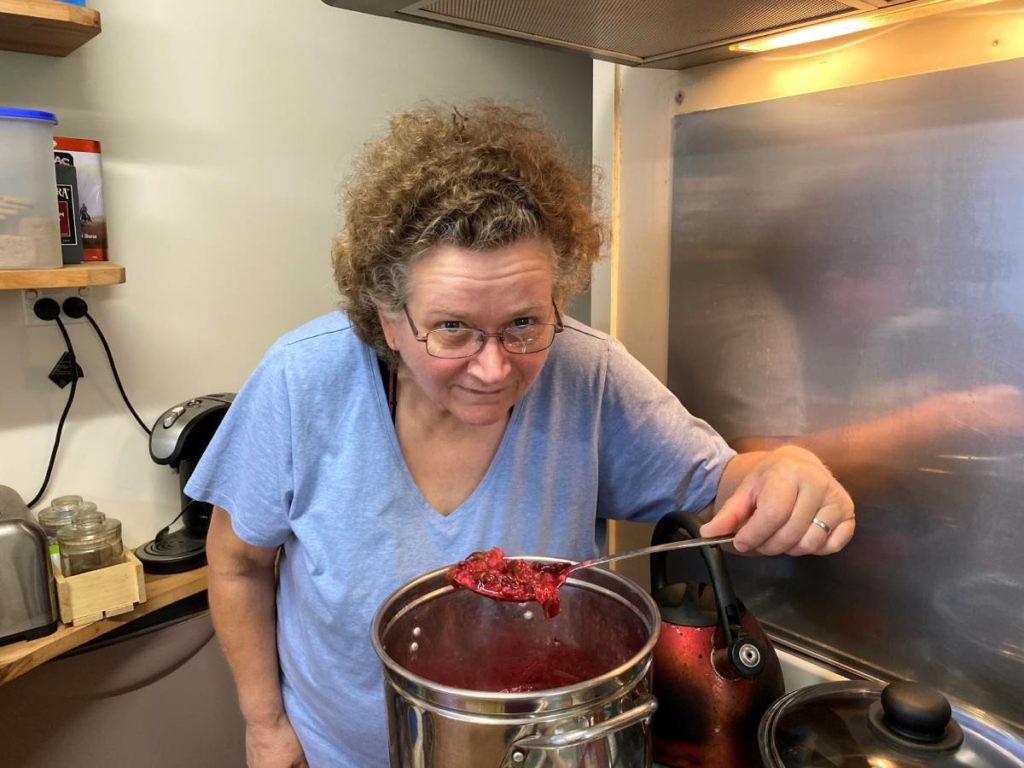
The smell in Marianna Reid’s kitchen is inviting as she stirs a silver pot full of homemade Brazilian treegrape jam, watching and waiting with patience through the delicate process of jam making.
It’s almost the end of winter, a time when the 60-year-old slows down her jam and marmalade making as the warm weather starts to creep in.
But there are still a few more recipes to be tried before the cooler days finish.
In her Alloway kitchen Marianna has spent the last weeks of winter using local seasonal fruit to create a of a handful of delicious jam and marmalade recipes.
Sitting at her dining table slicing lemons and limes methodically, there is a fresh fragrance of citrus that drifts through her home, before the sweet aroma of slow-cooking jam takes over the senses.
Marianna moved to the Bundaberg Region four years ago with her husband Brandon.
They purchased a small parcel of land packed full of all sorts of fruit trees from mangoes, blueberries and mulberries right through to lemons and lime – all of which she uses in her homemade jams and marmalades.
The quaint little kitchen doesn’t look like the place where master recipes are created, but it’s perfect for Marianna as she makes jar after jar of tasty jams that sell like hot cakes to her QCWA friends each week.
Marianna discovers Brazilian treegrape
In her latest recipe Marianna is using the Brazilian treegrape, a small, purple-black, white-pulped fruit which grows directly on the trunk of the Jabuticaba tree.
They can be eaten raw but have a tart taste or they can be used to make jellies, jams, juice or wine, just as regular grapes are.
Having never seen or heard of the Brazilian treegrape fruit before, Marianna said she discovered what the small thick-skinned berry, that was growing in her backyard, was by researching it on the internet and thought she wouldn’t let the opportunity, or the fruit go to waste.
Climbing the step ladder to reach the ripest fruit, Marianna collects the Brazilian treegrape fruit before she starts the four to six-hour jam making process.
“All my jams and marmalades are locally grown and produced,” Marianna said.
“Often if I don’t have the fruit growing here, people will give me their fruit or I go and pick it from their backyard, and in return I give them some of the jars.”

Marianna's homemade jams
Marianna is very particular when it comes to the process and the quality of fruit that goes in to making her homemade jams and marmalades, and with a history of working in the food industry as a quality control officers for almost two decades her knowledge shows through.
“I triple rinse everything first, before having a good look at the fruit,” she said.
“If there are any markings, you just throw them away as possums or something like that could have been at them.
“Now you have to be precise when it comes to making marmalade; if you have 1.5 kilos of fruit you need 1.5 litres of water to go in the pot at first and you heat them very slowly on low, and you keep stirring, and stirring before the fruit starts to become soft and you can start to mash it.
“Then you add the sugar, and I cheat now and use jam-setting sugar and low GI sugar cane sugar, so it is not as sweet.
“Then you will end up with 3 kilos of fruit.”

She said by using the seeds of fruit such as lemons and limes, the natural pectin was released and turned water to a jelly-like substance which meant there was no need to use gelatin.
“Cumquats are great to use, as you get the pectin from the seeds, or I use the seeds from the bush lemons and limes soaked in water to form the pectin that I add in,” she said.
“Overall it takes four hours to make each of the jams, and about six hours for the marmalades as it is made from citrus and cooked twice.
“I use the recipes from the wonderful QCWA book, it’s full of fantastic recipes.”

Marianna said this winter she had been busy making a variety of homemade jams and marmalades, include cumquat, citron, orange, lime, lemon and lime marmalades, and strawberry, Brazilian treegrape, Mexican lilly pilly, blue berry, mango, mango and mint, and mango and ginger jams.
For more information about Marianna's homemade jams or if you have an abundance of fruit you’d like her to use for jam, contact her by phoning 0413 493 162.
Marianna’s Brazilian treegrape Jam
Ingredients:
- 2kg of Brazilian treegrape fruit – diced.
- 1kg of jam setting sugar
- 1kg of low GI sugar
- *1 teaspoon of jam setter may be required

Directions:
Place 2kg of washed and diced Brazilian treegrapes in a large pot on a low heat.
Watching the fruit as it simmers on low until tender, this could take up to an hour and a half.
While the fruit is simmering clean about 10 glass jars with lids.
Once the fruit is tender blend to a smooth consistency, before running through a sieve, disregarding chucks.
Return to pot and add the jam setting sugar and low GI sugar, if the mixture does not form a set consistency, 1 teaspoon of jam setter may be required to be added at this time.
Stir jam until all sugar is dissolved on a slow boil, so not to burn the bottom.
*Over cooking the jam will result in a darker colour.
Preheat the glass jar and lids by scolding in hot water.
Once the sugar is dissolved fill the glass jars with jam; close and turn upside down for 10 minutes to ensure a proper seal.
Let the jars cool then label with date and jam type before sharing with friends and family.
- Other news: Sweet success for Apple Tree Creek Honey







